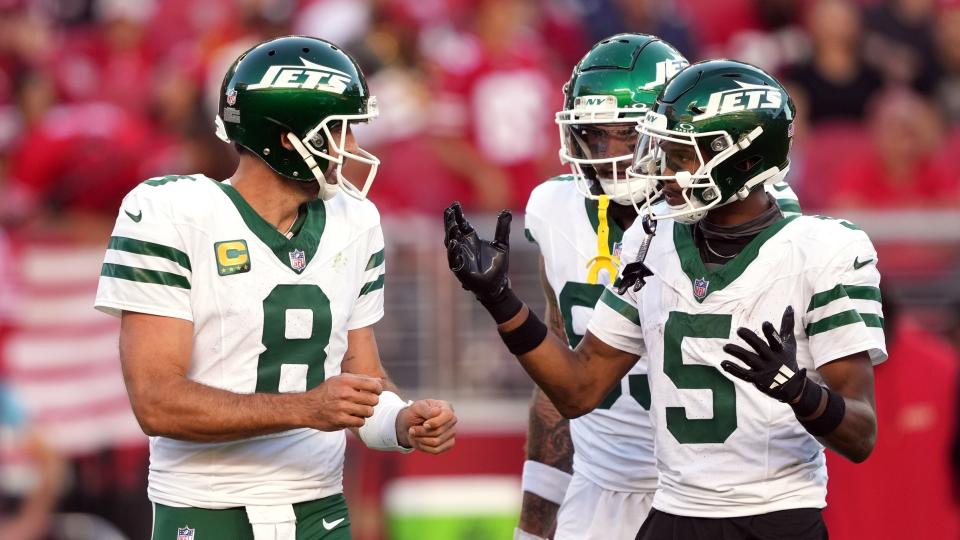How could Jets' potential Davante Adams trade impact Garrett Wilson?
The Jets’ ongoing efforts to get Aaron Rodgers and Garrett Wilson on the same page continued to provide a major talking point this weekend. After another shaky start, Rodgers and Wilson had some success in the second half of Sunday’s game, as Wilson ended up with a career-high 13 receptions for 101 yards and a touchdown.
At the same time, buzz continues to build around the possibility of the Jets making a trade for Davante Adams, who wants to leave the Raiders and has expressed a desire to be reunited with his long-time Packers teammate Rodgers.
We covered the pros and cons of a potential Adams trade last year before the Raiders ultimately decided to retain him. Everything discussed back then still applies now that he’s available once again: He’s still a productive player who would be affordable and a scheme fit, with automatic chemistry with Rodgers, but he's also over 30 and would require the Jets to give up assets.
The ongoing issues with Rodgers and Wilson have raised additional speculation about the potential impact of this move, though. Some have suggested Wilson’s apparent frustration will grow if it means he won’t see as many targets.
After Sunday's loss to Minnesota, Wilson reiterated that he just wants to win and that his own touches and numbers are not the top priority for him or the team.
Nevertheless, there is a concern that bringing in Adams could undermine the ongoing progress the Jets have made in terms of getting Rodgers and Wilson to see the game through each other’s eyes. The Jets came back from a 17-point deficit and had a chance to win the game in the closing minutes as the Rodgers and Wilson connection finally started to click in London.
There were a few communication breakdowns early on as Wilson had just 30 receiving yards on nine targets in the first half. However, rather than abandon attempting to get him involved, the Jets targeted him even more after halftime.
These in-game reps seemed to have value as the pair connected on several key plays during the Jets’ attempted comeback. By the end of the game, Wilson had been thrown to 22 times, which was the most targets for any Gang Green player in a game since target numbers began to be compiled in 1999.
If getting Adams means fewer targets for Wilson, the fear would be that this wouldn’t just mean an inevitable reduction in Wilson’s production but could also slow down the progress they’ve been making.
Wilson is far from being against the idea of bringing in Adams, though. "That’d be cool, man," he said on Friday when asked about the possibility of bringing him in. "If we can get him over here, it's like I always say: If someone can help us win, let’s do it."

While Wilson’s frustration has been hard to hide at times this year, it genuinely seems to stem from the team not having success rather than him being angry at not getting the ball enough or blaming someone else for things that go wrong.
On Sunday, he displayed the most frustration when he didn’t get to go into the game on fourth down as the Jets coaches made a late change and sent Irv Charles in to block instead. But he appeared more upset about the outcome of the play rather than pointing fingers at any teammates or coaches.
Ultimately, a move for Adams would have obvious benefits to Wilson as well. He can learn a lot from Adams, specifically in terms of how to optimize his connection with Rodgers.
The process of developing into one of Rodgers’ favorite targets was not an immediate one for Adams, either. Packers fans were frustrated with his progress during his second season before he made a leap in his third season and then went to his first Pro Bowl in year four. The 31-year-old should be able to guide Wilson through the process in a mentoring capacity, while also being someone who can lead by example.
The other obvious positive for Wilson would be that bringing in Adams would prevent teams from being able to divert as much defensive attention his way as they currently do. Wilson faced four of the better cornerbacks in the league over the first four games – Charvarius Ward, L’Jarius Sneed, Christian Gonzalez and Patrick Surtain II – but had his most productive game against a Vikings team whose starters are a past-his-prime Stephon Gilmore and a solid but far from elite Byron Murphy.
"[It] felt like we just had more opportunities today to get it to him," said Robert Saleh — who was fired on Tuesday — when asked about his thoughts on Wilson putting up his best numbers of the season. "We go into every game trying to get him the ball. He’s our No. 1 receiver."
Had Adams been around for the Denver game, it’s likely Surtain would have spent at least some of the time on him, giving Wilson opportunities for more favorable matchups against players like Riley Moss. The Jets adding Adams could also free Wilson up to play in the slot more, which could create mismatches.
Of course, nurturing Wilson’s talent is a long-term priority for the Jets, as he is a key part of their young nucleus. In the shorter term, winning games is an ongoing priority, and Rodgers should be here for the next few seasons. So it is important that he and Wilson can play well together, as they did in the second half on Sunday.
There’s no reason why Adams' potential arrival should undermine the progress the Jets have made so far and, as Wilson himself recognizes, Adams is a talented player who would improve the team and help their ability to win games.

